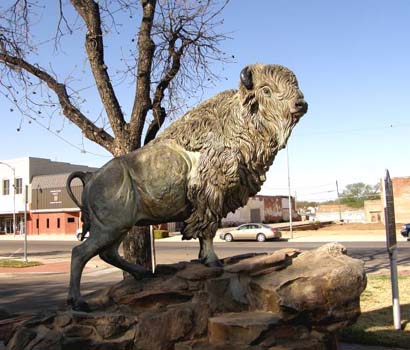| |
The
rifle roared, a .50 caliber hunk of lead smacked into the side of the buffalo
and the huge animal tumbled to the ground.
That happened all across the
plains of Texas during the 1870s,
but this was no ordinary bison – it was all white, one of only seven known to
have been killed on the North American continent.
And it was killed about
10 miles north of present day Snyder.
While
buffalo no longer roam the prairie, a life-sized statute commemorating that white
buffalo stands in the Scurry
County courthouse square. Beneath it is a historical marker about J. Wright
Mooar, the man who brought the white beast down. |
 |
Mooar took the white
buffalo on Oct. 7, 1876. Site of the kill was Deep Creek, a stream the town of
Snyder eventually
grew up around.
At the time, the greatest buffalo hunt in recorded history
was in progress. The animals were killed primarily for their hides, which were
used for many things. The carcass was left to rot on the plains, the bones bleaching
in the sun.
Said to have killed 22,000 buffalo from 1870 to 1880, Mooar
was born on Aug. 10, 1851 in Vermont. He came to Texas
in 1873 with his brother, John Webb Mooar.
He had started his career colorlessly
enough as a street car conductor in Chicago. He also worked as a carpenter and
spent a brief time working for the Army in Kansas as a wood cutter.
Mooar
first began killing buffalo to supply the Army with meat. When demand ran high,
he could get a quarter a pound for buffalo meat. In slack times, the market dropped
to a nickel a pound.
In 1876, the same year he took the white buffalo,
he sold 62,000 pounds of meat at Fort Griffin. He made only seven-and-a-half cents
a pound on that deal, but netted $12,000 for all the hides.
The Indians
considered the white buffalo to be sacred and would not kill one. But Mooar was
not the superstitious type.
The white buffalo in downtown Snyder is eight
feet long and five-and-a-half feet high at the shoulder. Though large as some
buffalo were in real life, the statue is said to be smaller than the bull Mooar
killed.
Mooar, of course, skinned the white buffalo and tanned its hide.
The hide still exists, still in the family of one of his descendants.
Buffalo
hunters were not noted for placidness. Operating well beyond the settlements,
they enforced their own law or did without.
The same year Mooar killed
the white buffalo, Jim, Jeff and Ben Webb moved to the Deep Creek country from
Austin. They found the hunting good,
but they had left their families back in Central
Texas and missed them.
Deciding to go fetch their kinfolks, they left
the buffalo hunting grounds and rode down the Colorado to Austin.
When they returned to their camp with their families, they got a grim welcome.
As they approached, they saw a body swinging in the breeze at the end of a rope
tied to one of the rare trees sturdy enough to hang a man from.
Nearby,
a group of buffalo hunters had gotten drunk and were working on getting drunker.
As the Webb boys got the story, the recently departed fellow had killed in a man
while arguing over cards.
The victim’s friends, convening a kangaroo court,
sentenced the killer to death by firing squad. But being too drunk to aim straight,
they had only wounded the condemned man. To put him out of his misery, they had
strung him up.
Not wanting their families to be any more traumatized than
they already were, the Webbs asked their colleagues to cut down the body. The
hunters complied, burying him near the man he had killed.
Though the Comanches
gladly would have scalped Mooar if they could have gotten their hands on him,
the buffalo hunter lived to be 89. To his dying day, he never felt it necessary
to apologize for helping to bring a species to near extinction.
© Mike
Cox
"Texas Tales"
November 18, 2008 column
More
Texas
Animals | Texas
Murders/Hangings |
|
Books by Mike Cox - Order Now |
| |